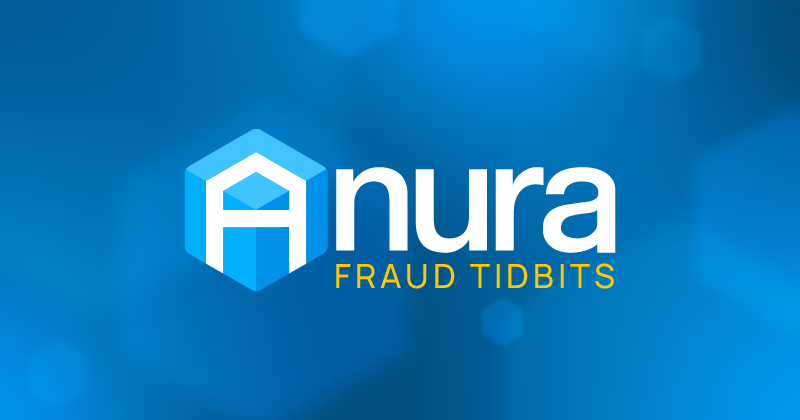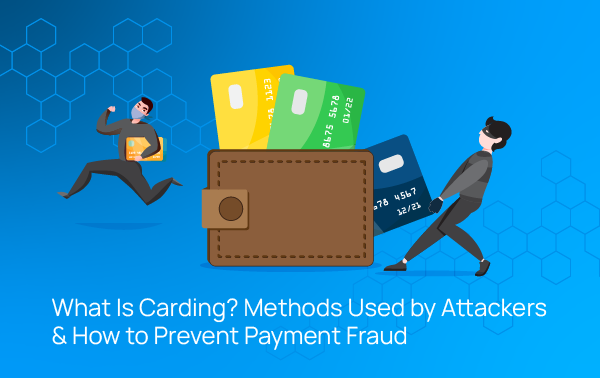What is Carding in eCommerce? The Dark Side of Online Fraud

TL;DR:
- Carding is a cybercrime in ecommerce where fraudsters test stolen credit card details using malicious bots to verify valid ones.
- These attacks can lead to fraudulent purchases, financial losses, and reputational damage for businesses.
- Gift card cracking is a variation of carding that exploits weaker security protections on gift card systems.
- Traditional fraud defenses like CAPTCHAs and IP blocking are ineffective against advanced bot attacks.
- Carding attacks often rely on carding bots sourced from a carding website, giving fraudsters quick carding proof that a stolen card is still active.
- A comprehensive fraud prevention solution is necessary to detect and block fraudulent transactions in real time.

What is Carding?
Carding is a type of cybercrime in ecommerce where fraudsters use stolen credit card details and automated bots to test which cards are valid. These operations are often coordinated through a carding website, where stolen data is exchanged, and automated tools are shared. This process, also called credit card stuffing, falls under automated transaction abuse.
The stolen data used in carding includes the cardholder’s name, credit card number, expiration date, CVV code, ZIP code, and birthday. Once verified, the valid card details are used for purchases or resold on the dark web. When an authorization succeeds, fraudsters gain carding proof that the payment method can be used for larger attacks.
Fraudsters deploy botnets to test stolen card details by attempting small transactions on different online platforms. These bots systematically enter various credit card number, expiration date, and CVV code combinations until a transaction is approved. Once authenticated, the fraudster can use the card to:
- Buy and resell gift cards
- Clone a physical credit card
- Sell the stolen data to other criminals
How Do Carding Attacks Work?
A typical carding attack follows these steps:
- Fraudsters get a list with stolen credit card details — via phishing scams, data breaches, or purchasing leaked information from the dark web.
- Bots test stolen card details — Fraudsters use botnets to automate small-value transactions and identify active cards.
- Valid cards are exploited — Attackers compile and use the verified data to withdraw funds, make purchases, or resell the information.
Throughout this process, carding bots rapidly cycle through stolen data to generate carding proof before launching full-scale carding attacks.
Why Do Fraudsters Use Bots in Carding Attacks?
Malicious bots, commonly known as carding bots, play a critical role in carding attacks by enabling fraudsters to test thousands of card combinations at scale, quickly and efficiently.
- Automation: Bots conduct thousands of rapid-fire transactions, making manual detection nearly impossible.
- IP masking: Attackers use proxies and VPNs to change their IP addresses constantly, bypassing traditional fraud detection methods.
- 24/7 operations: Bots run nonstop, continuously verifying stolen card information.
The Risks of Carding for Businesses
Carding attacks don’t just hurt consumers; they also create serious risks for online merchants:
- Chargebacks & Financial Losses — High levels of fraudulent transactions lead to chargebacks, increasing operational costs.
- Reputation Damage — Customers lose trust in merchants that experience frequent fraud incidents.
- Payment Processing Penalties — Processors like Visa and Mastercard fine businesses for excessive fraudulent transactions and may terminate merchant accounts.
- Transaction Freezes — Payment processors suspend transactions when suspicious activity is detected, leading to lost revenue.
What is Gift Card Cracking?
Gift card cracking is a variation of carding where fraud bots systematically test gift card numbers on retailer websites to find valid ones. Since gift cards lack personal identification details, they are easy for fraudsters to exploit.
Criminals frequently target websites with gift card balance check pages that have weak security protections. Once identified, stolen gift card balances are either used for purchases or resold on the dark web. Many of these gift card attempts are tied to larger carding attacks coordinated through a carding website, where criminals share tools and successful methods.
How to Spot a Carding Attack
Carding bots often try to mimic normal visitor behavior, but certain red flags can reveal their fraudulent intent. By monitoring these key indicators, businesses can detect and mitigate carding attacks before they escalate.
Unusual Payment Behavior Patterns:
High Volume of Declined Transactions: A surge in failed payment attempts may indicate bots systematically testing stolen card details.
Frequent Low-Dollar Transactions: Fraudsters often make small purchases ($1–$5) to verify card validity before attempting larger fraud.
Checkout & Shopping Cart Anomalies:
Abandoned Cart Spikes: An increase in abandoned shopping carts suggests bots failing authorization checks.
Repeated Visits to Checkout Pages: Bots may reload checkout pages multiple times to cycle through stolen card details.
Location & Device Red Flags
Multiple Transactions from a Single IP Address: Bots often cycle through numerous stolen cards from one location.
Use of Proxies or VPNs: Fraudsters frequently use IP masking tools, causing geolocation inconsistencies (e.g., a U.S. billing address used with a foreign IP).
Mismatched Payment Details
Different Billing & Shipping Addresses: Stolen cards often come from various sources, leading to mismatched information.
Unusual Email Addresses: Temporary or random email domains indicate fraudulent accounts.
Speed & Frequency of Transactions
Too Many Transactions in a Short Time: A real customer won't make dozens of purchases within seconds—bots will.
Unrealistic Typing & Navigation Speed: Automated scripts complete checkout details much faster than a human.
Repeated Use of the Same Card on Multiple Accounts
Fraudsters often rotate the same stolen credit card across numerous fake accounts to bypass fraud detection mechanisms.
By recognizing these warning signs, businesses can proactively implement security measures to stop carding fraud in its early stages.
Traditional Fraud Prevention Methods and Their Limitations
Many online businesses rely on outdated security measures that are ineffective against today’s sophisticated bot-driven fraud:
- CAPTCHAs: Easily bypassed by advanced fraud bots and human fraud farms.
- IP Blocking: Fraudsters use botnets, VPNs, and rotating proxies to disguise their activity, making IP blocking ineffective.
- Rate Limiting: While limiting the number of requests from an IP can slow attacks, bots can distribute attacks across thousands of IP addresses.
- Manual Fraud Reviews: Reviewing every flagged transaction is time-consuming and expensive.
These outdated tools cannot keep up with modern carding attacks that use advanced carding bots and IP obfuscation.
How to Stop Carding Attacks
Stop carding attacks in ecommerce with a fraud solution, like Anura, that accurately distinguishes between legitimate visitors and bots/human fraud. This way you stop the problem before it even happens and before fraudsters can even reach your website. The best defense blocks carding bots before they ever reach your payment form.
Protect Your Business Today
Don’t let fraudsters exploit your business. Sign up for Anura’s free 15-day trial and see how much fraud you’re preventing.
FAQs: Carding Attacks & Website Protection
How do I protect e-commerce sites from carding attacks?
To protect your e-commerce site from carding attacks, use advanced fraud detection tools that identify and block suspicious activity in real time. Look for patterns like high volumes of declined transactions, repeated low-dollar purchases, or mismatched payment details. Solutions that analyze behavior, not just IPs or CAPTCHAs, are essential to stop carding bots before they complete a transaction.
What is a carding website?
A carding website is an illegal platform, often hosted on the dark web, where cybercriminals buy, sell, or test stolen credit card information. These sites may offer tools or services like botnets or scripts to automate attacks on legitimate e-commerce stores. Businesses need to stay alert, as traffic from these sources can target checkout forms for automated fraud.
What does site carding mean?
Site carding refers to the act of using bots to test stolen credit card numbers directly on a retailer’s website. The goal is to verify which cards are active, usually by initiating low-value purchases. Once successful, fraudsters either make larger purchases or sell the “carding proof” data to others. Retailers can prevent this by monitoring for sudden transaction spikes and using tools that identify bot activity.
Are carding bots easy to detect?
No. Carding bots are designed to mimic real users, using techniques like IP masking. Basic fraud filters like CAPTCHAs or IP blocks are often ineffective. A real-time fraud prevention system with enviromental analysis is necessary to reliably spot and stop these bots.
What is carding proof?
Carding proof refers to the evidence fraudsters seek when testing stolen credit card information. During a card attack, bots perform small transactions to confirm whether a stolen card is active and valid. When a transaction is successful, that success is considered “proof” that the card works. Fraudsters then use or sell these verified cards, causing financial loss and chargebacks for ecommerce businesses.
What are carding bots?
Carding bots are automated scripts that run stolen credit card numbers through ecommerce checkout pages to see which ones are still active. A carding bot typically:
- Mimics human checkout behavior
- Cycles through thousands of stolen cards
- Uses proxies or spoofed IPs to evade security
- Works with a carding website or marketplace where data is shared
- Generates “carding proof” when an authorization succeeds
How does a carding bot work?
A carding bot automates the process of verifying stolen credit card data by running small-value transactions on ecommerce sites. The bot rapidly submits payment details, such as card numbers, expiration dates, and CVVs, until one is accepted. Once a valid card is confirmed, it’s marked as “live” and often used for unauthorized purchase or sold on the dark web. These automated attacks can result in chargebacks, account suspensions, and reputational damage for merchants.
What is site carding in ecommerce?
Site carding happens when fraudsters target a specific website to test stolen credit card numbers. The attacker uses bots to perform small test transactions directly on the merchant’s checkout page to identify which cards are valid. Once the bot verifies working cards, the fraudster either uses them for purchases or resells them. Site carding increases payment processor scrutiny, drives up chargeback fees, and can even result in a business losing its ability to process payments.
Quick Navigation
- 1. What is Carding?
- 2. How Do Carding Attacks Work?
- 3. Why Do Fraudsters Use Bots in Carding Attacks?
- 4. The Risks of Carding for Businesses
- 5. What is Gift Card Cracking?
- 6. How to Spot a Carding Attack
- 7. Traditional Fraud Prevention Methods and Their Limitations
- 8. How to Stop Carding Attacks
- 9. FAQs

